I've followed two guys building a boat on YouTube for more than two years. I see you doing some of the same calculating, measuring and fitting they have done except you're doing it in 1:48. I admire both them and you for your attention to detail and dedication to your respective crafts.
-

Win a Free Custom Engraved Brass Coin!!!
As a way to introduce our brass coins to the community, we will raffle off a free coin during the month of August. Follow link ABOVE for instructions for entering.
You are using an out of date browser. It may not display this or other websites correctly.
You should upgrade or use an alternative browser.
You should upgrade or use an alternative browser.
Hatch Coamings.
Framework around the gratings and ladder opening.
The aft/forward (also called coamings) are 3.18mm x 2.65mm (deep)
Athwartship, head-ledges, are 2.65mm.
The corner joints are a fancy half lap, said to be sloped or angled-this extra feature beyond me. In order to see the joint-line, the upper piece is simply made thinner.(1.25/1.40).
The upper part of the joint, seen above the planks, is rounded off. A small jig with a right-angle of a plank to be used, served to “blank off” the lower part that will remain square after sanding this rounding(also called radialising).
The grating should be thinned to reach the appropriate thickness. I used the milling machine as my attempts with a sanding board resulted in unwanted curving.
Black wood treenails represent bolts placed at joints and the center of the frame.
(Although I used different woods for the frame and gratings, when oiled, this is difficult to see. Different choice for other decks.)
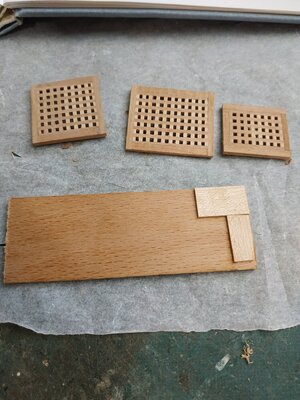
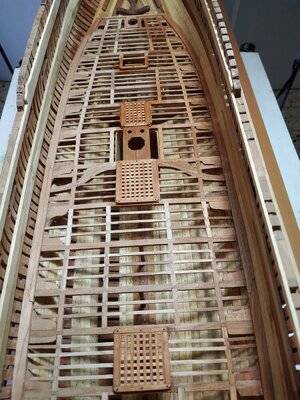
Framework around the gratings and ladder opening.
The aft/forward (also called coamings) are 3.18mm x 2.65mm (deep)
Athwartship, head-ledges, are 2.65mm.
The corner joints are a fancy half lap, said to be sloped or angled-this extra feature beyond me. In order to see the joint-line, the upper piece is simply made thinner.(1.25/1.40).
The upper part of the joint, seen above the planks, is rounded off. A small jig with a right-angle of a plank to be used, served to “blank off” the lower part that will remain square after sanding this rounding(also called radialising).
The grating should be thinned to reach the appropriate thickness. I used the milling machine as my attempts with a sanding board resulted in unwanted curving.
Black wood treenails represent bolts placed at joints and the center of the frame.
(Although I used different woods for the frame and gratings, when oiled, this is difficult to see. Different choice for other decks.)


Return to Deck Hook and Eking Piece.
When placing the foremost part of the central plank I realised I had made a fundamental error. In forgetting the TFFM instruction, I made the Eking piece stand proud of the beam,by dropping the beam, so that the waterway plank ended flush with this. So the front end of the deck needed unsticking. It and #1and #2 beams,the foremost waterway planks remade, and a new central piece joining the to the stemson, so they overlay the Deck Hook.
( As Miss Piggy would say “ attacked by DUMMO rays”)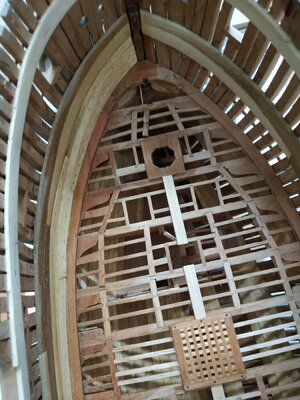
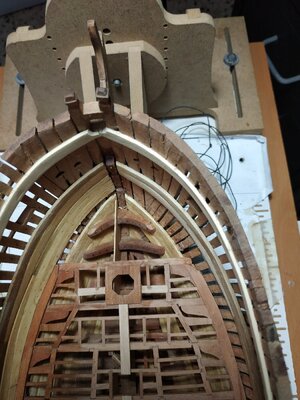
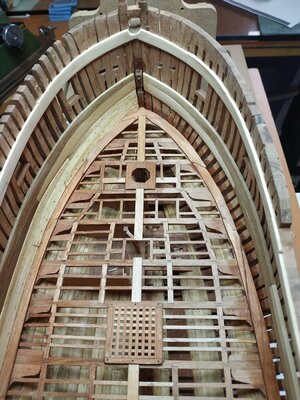
When placing the foremost part of the central plank I realised I had made a fundamental error. In forgetting the TFFM instruction, I made the Eking piece stand proud of the beam,by dropping the beam, so that the waterway plank ended flush with this. So the front end of the deck needed unsticking. It and #1and #2 beams,the foremost waterway planks remade, and a new central piece joining the to the stemson, so they overlay the Deck Hook.
( As Miss Piggy would say “ attacked by DUMMO rays”)



This is about as close to looking down on a full size sailing ship hull as I will ever come. The detail is impeccable.
Very impressive Stuglo, looks very nice.
Lower Deck Planking-cont.
In fact, before continuing, suggested making the Riding Bitts.
The PINS for this were made,so to fit location aft of #5 beam, where it is scored so as to support said beam.
These Pins must be scored to fit the UPPER deck beams-Which therefore have to be made first and appropriately positioned.
My bible, T(testament)FFM, refers me back to section 5.10 “as you did the lower deck”.
Luckily, I checked with ch. 8.4 (vol. 2 -Deuteronomy) where I found that the upper beam deck size is given as 4.77mm X 3.71mm and some words as to whether to let down onto the clamps or not. (Changes in instructions are also known when repeated in the other Bible).
22 beams are required.
Having tried various ways previously, I used the following method.
4 blocks, 16.5cm length, 5cmdeep and 1.0cm wide. (Thinner difficult to keep at 90deg)
Cut out pattern both sides of width.
Convex side, formed with spindle sander-flipping over frequently to ensure equal 90deg (same effect)
4.77mm slices with the table saw
Inscribe parallel line to form the concave surface( a little wider than the 3.71mm)
Finish more accurately with several passes between the milling drill bit and a fixed resistance.
The gap narrows progressively until the required thickness is obtained.
The beam passing by the bit, needs stabilizing as it passes the bit (I use a finger)
This way I only ruined 20% !!!!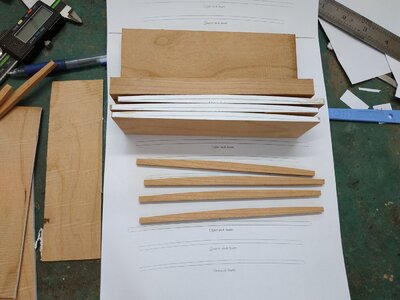
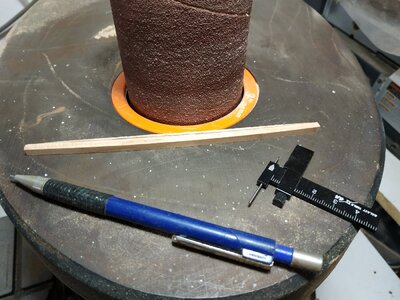
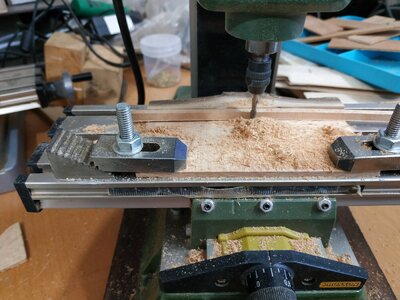
In fact, before continuing, suggested making the Riding Bitts.
The PINS for this were made,so to fit location aft of #5 beam, where it is scored so as to support said beam.
These Pins must be scored to fit the UPPER deck beams-Which therefore have to be made first and appropriately positioned.
My bible, T(testament)FFM, refers me back to section 5.10 “as you did the lower deck”.
Luckily, I checked with ch. 8.4 (vol. 2 -Deuteronomy) where I found that the upper beam deck size is given as 4.77mm X 3.71mm and some words as to whether to let down onto the clamps or not. (Changes in instructions are also known when repeated in the other Bible).
22 beams are required.
Having tried various ways previously, I used the following method.
4 blocks, 16.5cm length, 5cmdeep and 1.0cm wide. (Thinner difficult to keep at 90deg)
Cut out pattern both sides of width.
Convex side, formed with spindle sander-flipping over frequently to ensure equal 90deg (same effect)
4.77mm slices with the table saw
Inscribe parallel line to form the concave surface( a little wider than the 3.71mm)
Finish more accurately with several passes between the milling drill bit and a fixed resistance.
The gap narrows progressively until the required thickness is obtained.
The beam passing by the bit, needs stabilizing as it passes the bit (I use a finger)
This way I only ruined 20% !!!!



Last edited by a moderator:
Riding Bitts
The Pins of these have previously been made-they support the aft aspect of #5 lower deck beam.
They are repositioned, and checked to see if they are perpendicular. Slightly out, the scoring depth increased from 0.8mm to 1mm, did the job.
The #5 upper deck beam is positioned and its height is checked using the profile plan. In this case, resting,without letting down,gave the desired result.
This is marked against the Pins, and the scoring of 0.8mm is made using the milling machine.
The cross piece is now to be made.-6.89mm x 5.3mm of length 56.85mm.
The head is grooved with the shaped milling piece and the edges chamfered. (except aft - another piece will be added later).
Height (position) on the Pins is marked and again scored to 0.8mm.
The cross piece is fixed to the Pins, allowing 23.85 space between them,and the edges of the fore aspect chamfered - the more so the edges of the extensions outside of the Pins.
(I’ll leave it off the model until most of the deck is completed)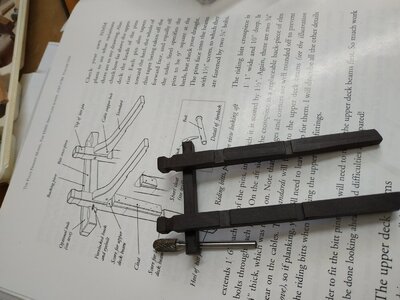
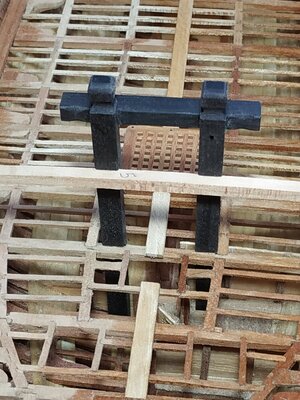
The Pins of these have previously been made-they support the aft aspect of #5 lower deck beam.
They are repositioned, and checked to see if they are perpendicular. Slightly out, the scoring depth increased from 0.8mm to 1mm, did the job.
The #5 upper deck beam is positioned and its height is checked using the profile plan. In this case, resting,without letting down,gave the desired result.
This is marked against the Pins, and the scoring of 0.8mm is made using the milling machine.
The cross piece is now to be made.-6.89mm x 5.3mm of length 56.85mm.
The head is grooved with the shaped milling piece and the edges chamfered. (except aft - another piece will be added later).
Height (position) on the Pins is marked and again scored to 0.8mm.
The cross piece is fixed to the Pins, allowing 23.85 space between them,and the edges of the fore aspect chamfered - the more so the edges of the extensions outside of the Pins.
(I’ll leave it off the model until most of the deck is completed)


Lower Deck -cont.
Reading again ahead, finish and fit the Riding Bitts. Add the Backing Piece of contrasting colour wood(was elm) 10.6x3.45 and 2.12 mm thick. Also using the same wood, wedge shaped cleats which add support for the upper deck beam.
Planking the Lower Deck- Beech wood
Ignoring the Let Down, the planks are 1.0mm thickness.I made them at 1.20mm to allow for “levelling”.
The first to be fitted are the Binding Strikes- a pair either side of the comings.
These are 5.3mm wide, tapering fore and aft- staggered 4 plank shift.
As a first for me, I marked the edges and ends with pencil to enhance the joint lines.
The spaces between the Binding Strakes and the Central Plank are “shut in”
Outside of the Binding Strakes, 5 narrower planks (4.75mm)with more marked tapering .
The next few planks (working outwards) would, if worked normally, would have ends that would be too narrow. These ends are modified so the plank is “Dropped”
( I drop things all the time but don’t have a special name- except “clumsy bugger”)
A plank, about a 1/3rd wider, is used, so that a barb-like end is formed (like a harpoon), so that the end of the neighbouring plank fits into the notch.
Decided for now to leave most of the port side unplanked-the rooms and bulkheads beneath are invisible, but the deck structures look good.
Finishing the planking-levelling and smoothing including the inner aspect of the waterway to match the plank height.
( I used sandpaper, single edge razor and larger, curved scalpel blades-see posts related to these subjects)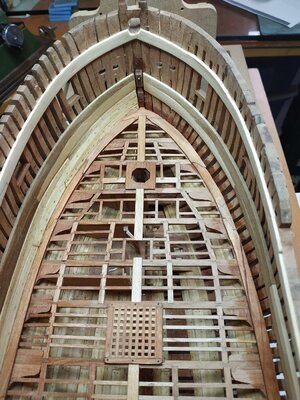
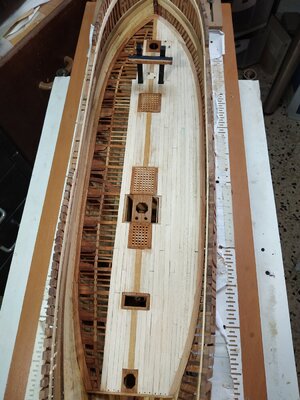
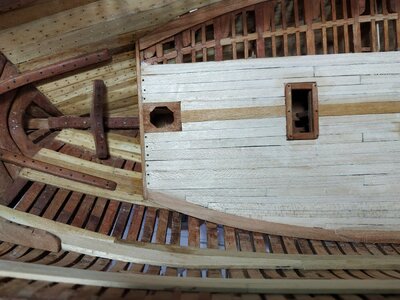
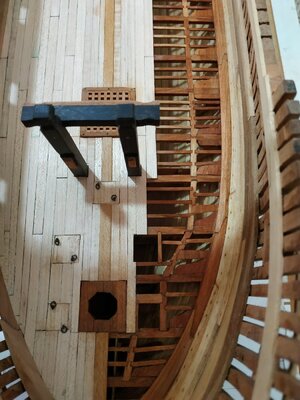
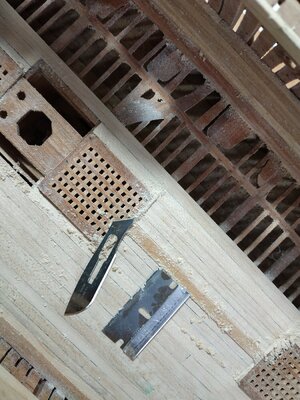
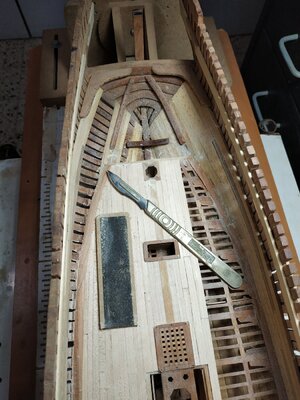
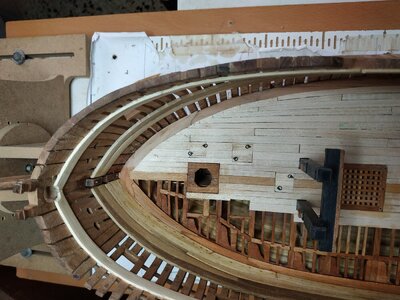
Reading again ahead, finish and fit the Riding Bitts. Add the Backing Piece of contrasting colour wood(was elm) 10.6x3.45 and 2.12 mm thick. Also using the same wood, wedge shaped cleats which add support for the upper deck beam.
Planking the Lower Deck- Beech wood
Ignoring the Let Down, the planks are 1.0mm thickness.I made them at 1.20mm to allow for “levelling”.
The first to be fitted are the Binding Strikes- a pair either side of the comings.
These are 5.3mm wide, tapering fore and aft- staggered 4 plank shift.
As a first for me, I marked the edges and ends with pencil to enhance the joint lines.
The spaces between the Binding Strakes and the Central Plank are “shut in”
Outside of the Binding Strakes, 5 narrower planks (4.75mm)with more marked tapering .
The next few planks (working outwards) would, if worked normally, would have ends that would be too narrow. These ends are modified so the plank is “Dropped”
( I drop things all the time but don’t have a special name- except “clumsy bugger”)
A plank, about a 1/3rd wider, is used, so that a barb-like end is formed (like a harpoon), so that the end of the neighbouring plank fits into the notch.
Decided for now to leave most of the port side unplanked-the rooms and bulkheads beneath are invisible, but the deck structures look good.
Finishing the planking-levelling and smoothing including the inner aspect of the waterway to match the plank height.
( I used sandpaper, single edge razor and larger, curved scalpel blades-see posts related to these subjects)







Looks very, very good, Stuglo.
Scuttle Covers
To the side and aft of the foremast. Flush to deck.
TFFM says battens on the inner side of carlings, but at least one of my scuttle doesn't have these-so just “fit” them so they don't fall when glued.Also ignored hinges.
The upper surface planks are narrower, they are supported by battens at 90deg.
The ring and bolts from an old kit of similar scale.
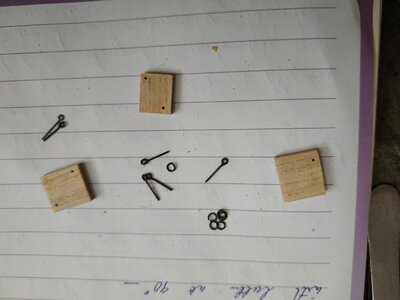
To the side and aft of the foremast. Flush to deck.
TFFM says battens on the inner side of carlings, but at least one of my scuttle doesn't have these-so just “fit” them so they don't fall when glued.Also ignored hinges.
The upper surface planks are narrower, they are supported by battens at 90deg.
The ring and bolts from an old kit of similar scale.

Last edited by a moderator:
Main Topsail Sheet Bitts and Main Jeer Bitts.
Having made the Riding Bitts, I thought these would be similar and relatively easy-HA! HA! HA!
Initially a lack of information in TFFM, then excess after searching vol 2 .Further complications when I tried to understand using the Peter Goodwin “construction and fitting” book. Different measures are given here. Also my profile and deck plans weren’t in agreement with anything. So checked up on Kevin Kenny’s video, to find he was also troubled and remade them (in video 80).
After many scribbled drawings, I decided to remember an earlier solution-take each stage as it comes. Maximum will have to restart.
Firstly, size of blank- 4.77 X4.77mm . But what length?
The length of the MTSB pins is such that they allow the upper surface of the Gallows Piece (a fancy cross piece sitting on the pins) to be in line with the surface of the quarter deck and to follow its curve.
In order to know the height of the quarter deck, check profile plans to ensure the the strakes/clamps are in the correct height- and note beams are only 2.9mm deep, but planking is 1.33mm thick.
So I start with the Gallows piece -
I took a blank of 60X3.75X7mm. I stuck a copy of the 1st option of patterns given inTFFM and sanded a curve to match- so that the depth was 5.83mm.
I then used a couple of interesting- looking milling bits to obtain the result required at either end and underside of this curve, so the length was 57.2mm.
The length of the MTSB pins are therefore height of quarterdeck above the lower deck, minus depth of Gallows plus the “Heel” inside the pump well-which in my case is 75.75.
You could read it off the plans but mine are unclear with superimposed markings)
I’m going to make the Main Jeer Bitts at the same time as the dimension of the blanks and workings are similar 4.77X4.77mm
Its length is such as to support the fore beam of the quarter deck - ie previously calculated height minus the thickness of beam and planking. With the “heel” this comes to 72.70mm
Having made the Riding Bitts, I thought these would be similar and relatively easy-HA! HA! HA!
Initially a lack of information in TFFM, then excess after searching vol 2 .Further complications when I tried to understand using the Peter Goodwin “construction and fitting” book. Different measures are given here. Also my profile and deck plans weren’t in agreement with anything. So checked up on Kevin Kenny’s video, to find he was also troubled and remade them (in video 80).
After many scribbled drawings, I decided to remember an earlier solution-take each stage as it comes. Maximum will have to restart.
Firstly, size of blank- 4.77 X4.77mm . But what length?
The length of the MTSB pins is such that they allow the upper surface of the Gallows Piece (a fancy cross piece sitting on the pins) to be in line with the surface of the quarter deck and to follow its curve.
In order to know the height of the quarter deck, check profile plans to ensure the the strakes/clamps are in the correct height- and note beams are only 2.9mm deep, but planking is 1.33mm thick.
So I start with the Gallows piece -
I took a blank of 60X3.75X7mm. I stuck a copy of the 1st option of patterns given inTFFM and sanded a curve to match- so that the depth was 5.83mm.
I then used a couple of interesting- looking milling bits to obtain the result required at either end and underside of this curve, so the length was 57.2mm.
The length of the MTSB pins are therefore height of quarterdeck above the lower deck, minus depth of Gallows plus the “Heel” inside the pump well-which in my case is 75.75.
You could read it off the plans but mine are unclear with superimposed markings)
I’m going to make the Main Jeer Bitts at the same time as the dimension of the blanks and workings are similar 4.77X4.77mm
Its length is such as to support the fore beam of the quarter deck - ie previously calculated height minus the thickness of beam and planking. With the “heel” this comes to 72.70mm
Main Topsail and Jeer Bitts (continued)
I’m posting the various stages in (I hope) digestible bits (pun intended)
Of course, cut the blanks slightly overlong.
Place an upper deck beam in position and measure and mark the upper surface height above the lower deck, on the Bitts.
The Aft surface is tapered below this line by about a ⅓-to 3.5mm
A “Heel” is then formed on the fore surface- notched to depth similar to a beam’s depth and about 2.50mm thickness left. This attaches to the top and side of the lower deck beams.
The Main Jeer Bitts: The hole in the corner of the after hatch should be enlarged to accommodate the Bitts, allowing for a separation of 22.26mm
(Main Topsail Bitts are separated by 23.85mm but there is space for this in the pump well.)
The Bitts are now scored to depth 0.75mm on fore aspect to allow them to fit the upper deck beams.
The Cross Pieces -Main Topsail Bitt 3.10x4.25mm-with different lengths to choose from,I made it 51.25mm
-Main Jeer 3.10x4.25x45.9mm
**NOTE**that the Jeer Bitt has the cross piece AFT of the Pins.
Also scored 0.75mm, the UPPER surface of the Cross Piece, is 11.13mm above the upper deck.
I’m posting the various stages in (I hope) digestible bits (pun intended)
Of course, cut the blanks slightly overlong.
Place an upper deck beam in position and measure and mark the upper surface height above the lower deck, on the Bitts.
The Aft surface is tapered below this line by about a ⅓-to 3.5mm
A “Heel” is then formed on the fore surface- notched to depth similar to a beam’s depth and about 2.50mm thickness left. This attaches to the top and side of the lower deck beams.
The Main Jeer Bitts: The hole in the corner of the after hatch should be enlarged to accommodate the Bitts, allowing for a separation of 22.26mm
(Main Topsail Bitts are separated by 23.85mm but there is space for this in the pump well.)
The Bitts are now scored to depth 0.75mm on fore aspect to allow them to fit the upper deck beams.
The Cross Pieces -Main Topsail Bitt 3.10x4.25mm-with different lengths to choose from,I made it 51.25mm
-Main Jeer 3.10x4.25x45.9mm
**NOTE**that the Jeer Bitt has the cross piece AFT of the Pins.
Also scored 0.75mm, the UPPER surface of the Cross Piece, is 11.13mm above the upper deck.
Main Topsail and Jeer Bitts (continued further)
NOW we notice that the fancy top to the pins are not straight but have a sort of mushroom top (or something else which I shan’t mention)- suddenly wider then tapering. At first glance I see a number of possible solutions:-
Remake the pins to widest dimension and shape back
Make a separate piece to stick on to a shortened top
Add a thickening blanks to shape and then carve decoration.
Taper existing end and add battens to form a rhomboid shaped “window”
Checked KK’s video-he went with the last option.
I could have done with then tilting table he used for milling, but used a stationary sanding block to reduce the top10mm of the pins from 4.77mm to 3.77mm-result could have been better but I was impatient.
I have left over from Dusek’s La Real cutout sheets some strips 0.5mm thick and varying 1.2 to 1.5mm wide that surround parts cut out by laser.(remember never to throw anything away).
The wider stuff for the top and bottom, alternating thin and thicker for sides to overlap.
Chamfering to round edges and blend corners.
Some black acrylic paint matches quite well. (Just to the additions.)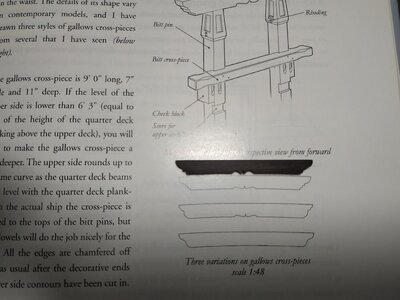
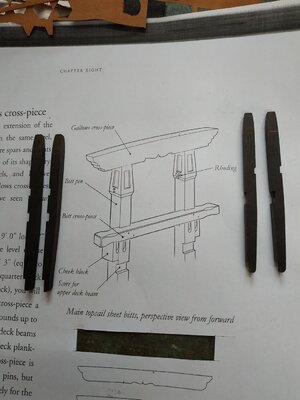
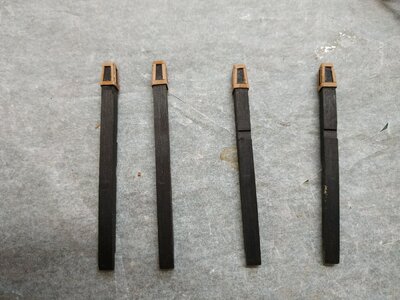
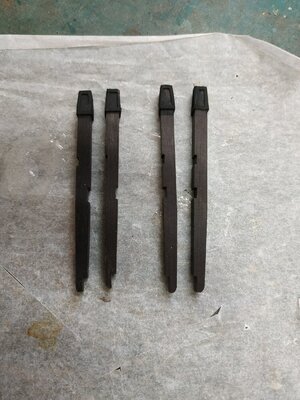
NOW we notice that the fancy top to the pins are not straight but have a sort of mushroom top (or something else which I shan’t mention)- suddenly wider then tapering. At first glance I see a number of possible solutions:-
Remake the pins to widest dimension and shape back
Make a separate piece to stick on to a shortened top
Add a thickening blanks to shape and then carve decoration.
Taper existing end and add battens to form a rhomboid shaped “window”
Checked KK’s video-he went with the last option.
I could have done with then tilting table he used for milling, but used a stationary sanding block to reduce the top10mm of the pins from 4.77mm to 3.77mm-result could have been better but I was impatient.
I have left over from Dusek’s La Real cutout sheets some strips 0.5mm thick and varying 1.2 to 1.5mm wide that surround parts cut out by laser.(remember never to throw anything away).
The wider stuff for the top and bottom, alternating thin and thicker for sides to overlap.
Chamfering to round edges and blend corners.
Some black acrylic paint matches quite well. (Just to the additions.)




Last edited:
Main Topsail and Jeer Bitts (continued further again)
CHAMFERING AT THE BITT to finish- moved on to the Cheek Blocks.
These thin structures - like a flattened “C” cover the outer sheave (single pulley disc)
This sheave is 4mmx0.6mm.
I took the height as 8mm, width as 4.77 (as pins) and thickness, 2.5mm.
The Cheek blocks sit on the deck, the portion above the sheave is thicker and finished as a molding.
Taking a blank 8mm deep,2.5mm thick and 20mm long , I Milled a groove 0.8 deep (it turned out 1.0mm) and 4.2mm wide - leaving 1.5mm wood to base and side, and 2.3 above.
The thicker top was milled with a shaped bit to produce the molding.
(I tried , for the first time, the Artesenia molding tool with little result)
Good result, but I stupidly put the molding facing inward- Start again!
Cut slices of appropriate width-4.77mm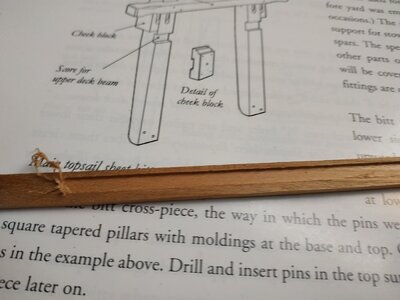
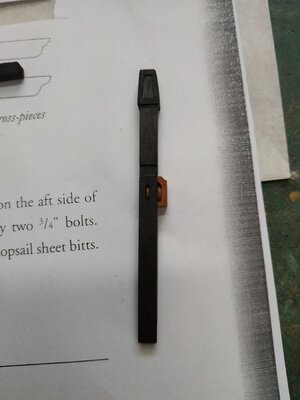
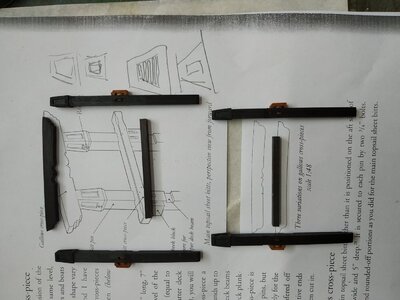
The Pins have a matching slit,at the same level, but for a sheave slightly wider at 0.93.
As I have no brass rods,(which I couldn’t cut to size anyway), no same-size metal washers, I cut them from a 4mm rod.
I think they look OK.
CHAMFERING AT THE BITT to finish- moved on to the Cheek Blocks.
These thin structures - like a flattened “C” cover the outer sheave (single pulley disc)
This sheave is 4mmx0.6mm.
I took the height as 8mm, width as 4.77 (as pins) and thickness, 2.5mm.
The Cheek blocks sit on the deck, the portion above the sheave is thicker and finished as a molding.
Taking a blank 8mm deep,2.5mm thick and 20mm long , I Milled a groove 0.8 deep (it turned out 1.0mm) and 4.2mm wide - leaving 1.5mm wood to base and side, and 2.3 above.
The thicker top was milled with a shaped bit to produce the molding.
(I tried , for the first time, the Artesenia molding tool with little result)
Good result, but I stupidly put the molding facing inward- Start again!
Cut slices of appropriate width-4.77mm



The Pins have a matching slit,at the same level, but for a sheave slightly wider at 0.93.
As I have no brass rods,(which I couldn’t cut to size anyway), no same-size metal washers, I cut them from a 4mm rod.
I think they look OK.
Main Topsail and Main Jeer Bitts (almost finished).
Next suggested making holes for the Pump Brake Rhodings- bearings that hold the crank handles.
Set at an axis of 23.32mm above the deck - one hole above and another below separated by 2.16mm.
Decided to make and fit them now-see vol 2 TFFM
Suggested made of bronze with an internal diameter of 0.8mm
The MT Bitts have a wider separation than the MJ pair and therefore they have spacer blocks to compensate (maintain alignment).
Again no suitable brass tubing, so used a 18G needle (medical) which has an int. Diameter of 0.9mm.Later added a spot of copper paint.
The Spacer,a wood strip, 2.66x1.5mm, grooved to depth of 0.75mm to take a length cut off from the needle. I made it 2.5mm wide. In retrospect it is probably too wide.
I epoxied similar lengths to the MJ bitts.
Used copper pins,but actually forgot to square the heads for the locking nuts.
Fitted the cross pieces and Gallows - just remember which “bit” goes with what and where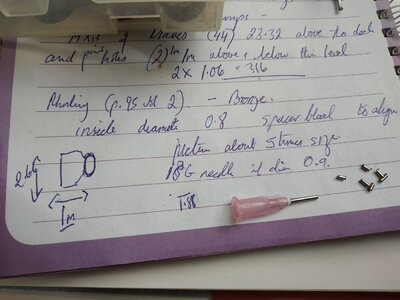
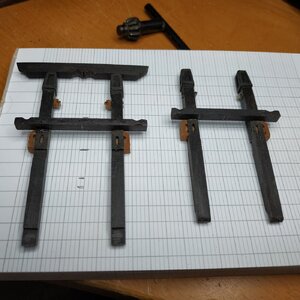
Next suggested making holes for the Pump Brake Rhodings- bearings that hold the crank handles.
Set at an axis of 23.32mm above the deck - one hole above and another below separated by 2.16mm.
Decided to make and fit them now-see vol 2 TFFM
Suggested made of bronze with an internal diameter of 0.8mm
The MT Bitts have a wider separation than the MJ pair and therefore they have spacer blocks to compensate (maintain alignment).
Again no suitable brass tubing, so used a 18G needle (medical) which has an int. Diameter of 0.9mm.Later added a spot of copper paint.
The Spacer,a wood strip, 2.66x1.5mm, grooved to depth of 0.75mm to take a length cut off from the needle. I made it 2.5mm wide. In retrospect it is probably too wide.
I epoxied similar lengths to the MJ bitts.
Used copper pins,but actually forgot to square the heads for the locking nuts.
Fitted the cross pieces and Gallows - just remember which “bit” goes with what and where


The Chain Pumps.
As usual, TFFM gives a good explanation.
A down (Back) tube, inboard,with intake at base.
An up (Discharge) tube .
These are topped with an assembly including a wheel and roller. Surrounding these is a cistern.
The tubes are pencil-shaped,98mm long, 5.3mm wide at top and tapering to 4.0mm at bottom.
There is a consistent bore of 2.65mm, therefore the wall thickness thins significantly.
There is also a pair of Brake pumps, similar in external size but with a narrowing bore (to 2.4mm) which is essential for its mode of function.
I used 5.3x5.3 blanks, 100mmlong. Holes drilling in initial few cms. With a drill press-enure bit is centralised
Already had the jig as suggested, but my skill with a plane is lacking.
Still able to use the “7-10-7” rule as suggested, but used a mill instead.
Dusting of my Pythagorus, (? remember the song” the square of the hypotenuse….”), the depth of cut can be easily calculated.=1.1mm
The corners are milled off and we have 8 sides.
The tapering achieved by raising the lower end with a 0.65 slip of wood,remilling against the gradient with a slightly shallower cut.
The top 6mm of all are rounded (like a pencil) to a diameter of 4mm.Where this starts,a collar of 2mm black paper to mimic an iron band.
The Brake pumps have a modified band which can be fitted later.
These also have a modified lower end- inboard is shaped like a fountain pen nib.
Finally, a hole to allow a 1.6 bore pipe (a short discharge tube), to protrude aft/outwads at 45deg.- I set this after checking the upper deck level.
( I have purchased a set of Photo-etched details from a fellow Swan builder)
I tried to build the Pump Intake Chamber-too fiddly and no patience)
*****This means that the Tubes will sit lower and this should be allowed for*****
(After the complexities of the Bitts, this was FUN and I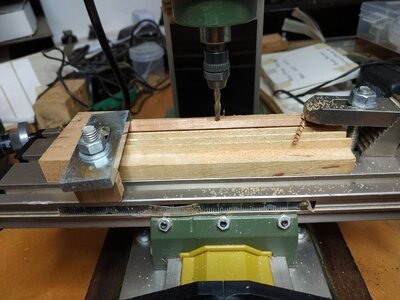
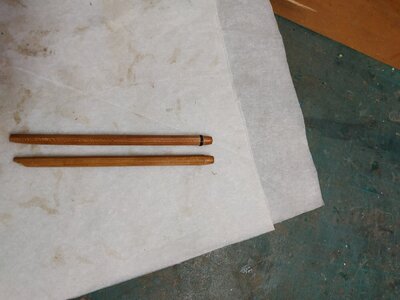 forgot to take pictures)
forgot to take pictures)
As usual, TFFM gives a good explanation.
A down (Back) tube, inboard,with intake at base.
An up (Discharge) tube .
These are topped with an assembly including a wheel and roller. Surrounding these is a cistern.
The tubes are pencil-shaped,98mm long, 5.3mm wide at top and tapering to 4.0mm at bottom.
There is a consistent bore of 2.65mm, therefore the wall thickness thins significantly.
There is also a pair of Brake pumps, similar in external size but with a narrowing bore (to 2.4mm) which is essential for its mode of function.
I used 5.3x5.3 blanks, 100mmlong. Holes drilling in initial few cms. With a drill press-enure bit is centralised
Already had the jig as suggested, but my skill with a plane is lacking.
Still able to use the “7-10-7” rule as suggested, but used a mill instead.
Dusting of my Pythagorus, (? remember the song” the square of the hypotenuse….”), the depth of cut can be easily calculated.=1.1mm
The corners are milled off and we have 8 sides.
The tapering achieved by raising the lower end with a 0.65 slip of wood,remilling against the gradient with a slightly shallower cut.
The top 6mm of all are rounded (like a pencil) to a diameter of 4mm.Where this starts,a collar of 2mm black paper to mimic an iron band.
The Brake pumps have a modified band which can be fitted later.
These also have a modified lower end- inboard is shaped like a fountain pen nib.
Finally, a hole to allow a 1.6 bore pipe (a short discharge tube), to protrude aft/outwads at 45deg.- I set this after checking the upper deck level.
( I have purchased a set of Photo-etched details from a fellow Swan builder)
I tried to build the Pump Intake Chamber-too fiddly and no patience)
*****This means that the Tubes will sit lower and this should be allowed for*****
(After the complexities of the Bitts, this was FUN and I

 forgot to take pictures)
forgot to take pictures)Upper Well
As the pumps pass through the lower deck, they are enclosed by a Well or compartment(-as they do below the deck).
It consists of louvred walls and a small door (port side). Corner pillars extend to the upper deck beam, and a pillar for the doorway-3.18 x 3.18mm.
Loovers 0.8x4mm and angled at 30deg.seperated 1.5mm
Vertical bottom plank 6.36x0.8mm notched athwartships to allow for mast partner.
Main challenge is the slots in the posts.
Following the ideas for making the gratings, by using a fine tooth Proxxon table saw blade (miraculously 0.8mm) and a 30deg jig. Remember directions of slots to allow the looves to match between posts.
Also vertical slots (milled) for the vertical bottom plank.
A simple door.
The overall size to fit space between main and aft hatches and cover the lower well.
This was a fun piece to make.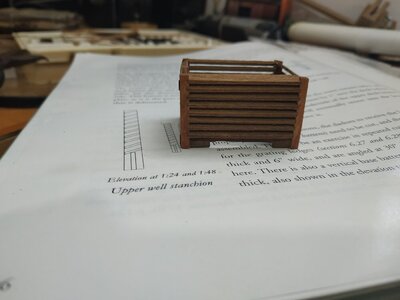
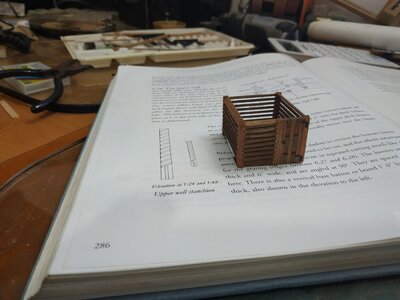
As the pumps pass through the lower deck, they are enclosed by a Well or compartment(-as they do below the deck).
It consists of louvred walls and a small door (port side). Corner pillars extend to the upper deck beam, and a pillar for the doorway-3.18 x 3.18mm.
Loovers 0.8x4mm and angled at 30deg.seperated 1.5mm
Vertical bottom plank 6.36x0.8mm notched athwartships to allow for mast partner.
Main challenge is the slots in the posts.
Following the ideas for making the gratings, by using a fine tooth Proxxon table saw blade (miraculously 0.8mm) and a 30deg jig. Remember directions of slots to allow the looves to match between posts.
Also vertical slots (milled) for the vertical bottom plank.
A simple door.
The overall size to fit space between main and aft hatches and cover the lower well.
This was a fun piece to make.


Last edited by a moderator:
Ladder
(Back to building after 10 days in and around Napoli-Fantastic place-visit if you can.)
Styles (sides) 0.8-1mm (size apparently flexible)-each with opposite direction of slots.
Treads (steps) 0.53 x4.24mm
The ladder feet are on the port side, inclined at 65deg.-this angle sets the slots horizontal and an angled jig can be used along with the “grating” method.
I have a smaller Proxxon table saw which has a 0.5 wide blade. No height adjustment so wood raised by another piece of suitable thickness.
The Styles are shaped- the top notched to fit the coaming, then other corner chamfered.
The middle ⅔ are narrowed by 0.75mm (supposedly to lighten)
Overall length to fit .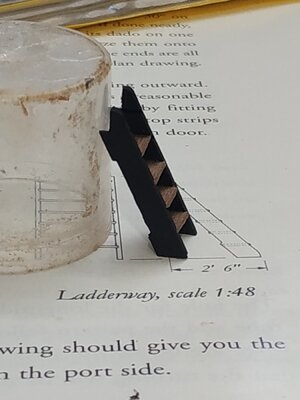
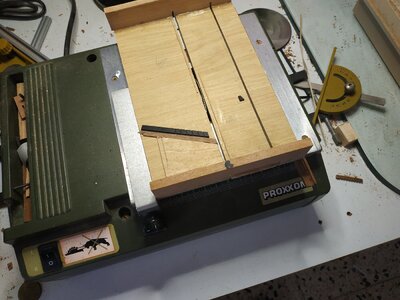
(Back to building after 10 days in and around Napoli-Fantastic place-visit if you can.)
Styles (sides) 0.8-1mm (size apparently flexible)-each with opposite direction of slots.
Treads (steps) 0.53 x4.24mm
The ladder feet are on the port side, inclined at 65deg.-this angle sets the slots horizontal and an angled jig can be used along with the “grating” method.
I have a smaller Proxxon table saw which has a 0.5 wide blade. No height adjustment so wood raised by another piece of suitable thickness.
The Styles are shaped- the top notched to fit the coaming, then other corner chamfered.
The middle ⅔ are narrowed by 0.75mm (supposedly to lighten)
Overall length to fit .


Last edited by a moderator:





